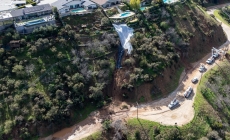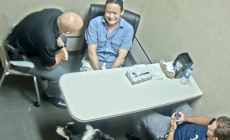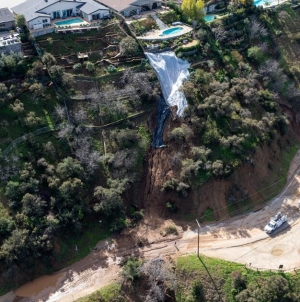-
Russia Strikes Ukraine’s Railways and Vows to Slow Arrival of U.S. Aid - April 26, 2024
-
A portion of Mulholland Drive, damaged by mudslides in winter storms, reopens - May 26, 2024
-
‘Maybe You Don’t Want to Win’ - May 26, 2024
-
Donald Trump Putting Law Enforcement in Danger: Attorney - May 26, 2024
-
Avoid the waters of these 5 L.A. County beaches this holiday weekend, public health officials say - May 26, 2024
-
Bawdy Comedy ‘Anora’ Wins Palme d’Or at Cannes Film Festival - May 26, 2024
-
Map Shows Heat Wave Zone Spread Into Five New States - May 26, 2024
-
Azusa police arrest suspected slingshot-wielding vandal - May 25, 2024
-
Donald Trump Hammers Judge Ahead of Jury Instructions - May 25, 2024
-
Sometimes U.S. and U.K. Politics Seem in Lock Step. Not This Year. - May 25, 2024
Russia Strikes Ukraine’s Railways and Vows to Slow Arrival of U.S. Aid
Russia attacked railway facilities in three different regions across Ukraine on Thursday night and Friday morning, as the country’s defense minister vowed to step up strikes aimed at slowing the flow of critically needed American weapons and equipment to the front.
At least six civilians were killed and 31 others injured in the attacks, according to the Ukrainian military and local officials. Three of the dead were railway workers killed by a strike in the Donetsk region. In Balakliya, a rail hub in the Kharkiv region, 13 passengers on a regional train were injured when a missile hit the station. Russia also attacked a railway facility in the Cherkasy region but no casualties were reported.
Ukrainian railways, with an estimated 12,000 miles of tracks and 230,000 employees, have played a crucial role in the war, evacuating civilians from frontline areas, transporting everything from grain to humanitarian assistance around the country, and moving heavy weapons supplied by Western allies along carefully guarded and hidden supply lines.
The latest attacks on the rail network came after Russia’s defense minister, Sergei Shoigu, promised to target Western weapons as they arrived in Ukraine. “We will increase the intensity of strikes on logistics centers and storage bases of Western weapons,” he said in a speech Tuesday at the ministry.
On Friday afternoon, Kyiv City Hall announced the evacuation of two hospitals next door to each other in the capital, citing a threa to attack them. A video had circulated online showing a man, naming the address and asserting that soldiers were being treated in them, “hiding behind the backs of children.”
The City Council’s statement said that this claim was untrue. The video’s origin had not been independently verified by The New York Times.
After the evacuations were announced, some parents took their children out of the hospitals. Medical workers were moving other children from intensive care. Patients who were not mobile were being removed by ambulance.
At a speech in Berlin welcoming recent announcements of new aid from the United States and other allies of Ukraine, the NATO secretary general, Jens Stoltenberg, stressed the need for quick action: “It is now our responsibility to turn these commitments into real deliveries of weapons and ammunition. And to do so quickly,” he said.
Ukrainian forces are hoping to see fresh supplies of weapons arrive at the front lines as soon as possible because they are engaged in fierce clashes and are struggling to hold their defensive lines in several locations. Russian forces have taken a string of villages west of Avdiivka, in the Donetsk region, but their next big goal in that direction, the city of Pokrovsk, is still 18 miles away.
The pressure on Chasiv Yar, a small but strategically located town, is greater. In March, Russia stepped up its efforts to capture the town, perched on a hill about five miles west of Bakhmut. Its forces have reached the Eastern outskirts. Capturing the town would help Russia to launch further offensive operations against larger cities, like Kostyantynivka, Kramatorsk and Sloviansk, major population centers in the Ukrainian-held part of the Donbas region.
Meanwhile, in the northeastern Kharkiv and Sumy regions, close to the Russian border, guided aerial bomb attacks on Friday morning struck two villages, killing one woman and injuring several more people, including at least three children, according to local authorities and media.
Attacks between Jan. 1 and March 31 resulted in the deaths of 25 children, according to data verified by the United Nations — the youngest just 2 months old. Nine children were reportedly killed in attacks during the first three weeks of April.































